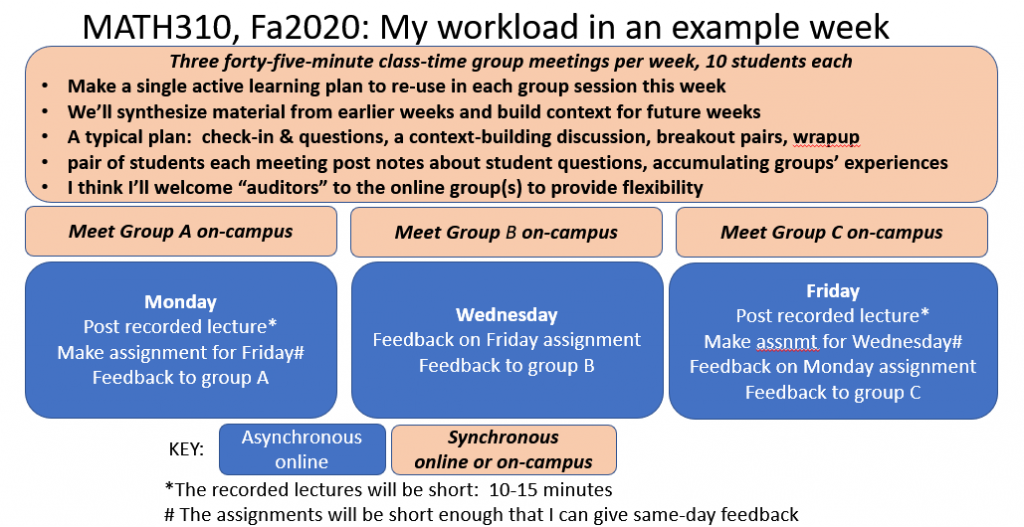Registration: 30
The students in this class are typically sophomore math majors for whom it serves as an “introduction to theorems and proofs” course, math minors for whom this serves as the final course in the “applied mathematics” minor sequence, and senior math majors who are interested in gaining familiarity with a new mathematical topic.
The students’ submissions for routine assignments are typically quite short once written, but require a lot of thought on their own time. This is what sets this — and other abstract proof-based mathematics courses — apart from students’ earlier work in calculus, for example.
I often reassure frustrated students that everybody who ever got good at mathematics has felt exactly the same frustration. This fact makes it especially important for this course design to provide opportunities for students to share their experiences and their thought processes with other students and for these groups to have support and guidance from the instructor.
Workload in a typical week of MATH310

I plan three 45-minute class-time group meeting per week, 10 students per group. I’ll make a single active learning plan to re-use in each group session during the week. We’ll synthesize material from earlier weeks and build context for future weeks. A typical meeting plan will be: chieck-in and questions, a context-building discussion, brekout pairs, wrap-up. A pair of students each meeting will post notes about the student questions to an accumulating group notes document. I’ll welcome auditors to the online group(s) to provide flexibility for students who need to quarantine or who may be feeling unwell that day.
Monday
- post recorded lecture
- make assignment for Friday
- Meet Group A
- Feedback to Group A
Wednesday
- Feedback on Friday work
- Meet Group B
- Feedback to Group B
Friday
- post recorded lecture
- make assignment for Wednesday
- Feedback on Monday work
- Meet Group C
- Feedback to Group C
The video lecture recordings will be 10-15 minutes. I’ll structure the homework so that it is quick to grade, allowing me to provide feedback on the same day work was due.
Load balancing online and on-campus sessions
My plan is to structure the real-time meetings so that the student experience and my workload is approximately the same whether online or on-campus. Some decisive action will be needed at the start, once it is clear which students will be on-campus and which will be online. I imagine a few scenarios:
- Assuming there are different but sizable proportions of onsite and online students, the scheduling is natural for the face-to-face work: do the real-time sessions proportionally onsite and online to balance the size of each session.
- If in a given class has ALL onsite students, there’s no problem at all
- If there are only a few online students in a class full of onsite students (I think that’s the worry, right?) I would structure my course as in the first case, and cycle the onsite students through the online group.
- Another idea for the lots of on-campus learners and only a few online: Enlist on-campus students with suitable devices — like phones— to buddy up with online students using Teams, acting as micro-moderators between the on-campus and online live participants!
- Finally, if a given class has only a few onsite students among mostly online students: God bless them. I think I’d privilege them with a smaller weekly session of their own, and split the online students into as many groups as I can sustainably handle. Here I’m counting on reusability of group materials to make that burden seem less heavy
Can groups learn from each other?
- Assuming the online sessions are really “all together” and not in breakout groups, they could be recorded easily
- I’m planning to assign a pair of students, on a weekly rotation, to post notes from the meeting to an accumulating notes document.
- The technical challenges of recording the onsite meetings are immense: a single camera and mic may be OK for a single lecturer, but of course I’m planning for that kind of one-way content delivery to happen asynchronously. An onsite recording that captures classroom discussion adequately would require lots of cameras and mics which won’t be available.
- I think I’ll welcome students from other groups to “audit” the online group meetings, either to get extra time in the discussion or to make up for a missed on-campus meeting.
